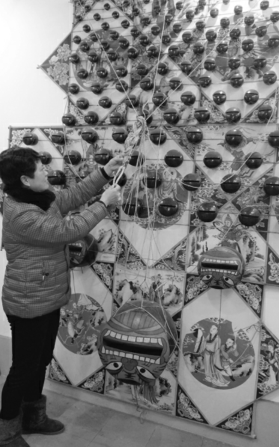
Shan Juan is among a few kite artists specializing in making the traditional Banyao Kite at Rugao, in Nantong, Jiangsu province.[YANG YAO/CHINA DAILY]
They sound like a hundred flutes, playing melodically as they dance among the clouds. As the Nantong whistle kites drift over the fields, you hear them before you see them. Banyao (ban means board and yao means snipe), the large, flat whistling kites, are large and flat with hexagon-shaped frames that flaunt exquisite decorations with vibrant colors.
Shan Juan is a kite specialist and her family is steeped in the traditions of kite art in Rugao, in Nantong, Jiangsu province.
She relishes every opportunity to explain the history of the folk art that was listed as an intangible cultural heritage by the State Council in 2006.
"Banyao kites are different from those in the north—more exquisite and elegant," Shan says. She says the kite is called "yuan (glede, a bird of prey)" in the north and "yao (snipe)" in the south.
"In the sky, the 'snipes' not only dance but also sing songs," she says, noting that the bright colors and the whistles represent aspirations and expectations for a happy life.
Kite-makers usually install between 100 and 300 whistles on each kite, but some kites can have up to 1,000.
"Westerners often call it a symphony of air," Shan says.
The process of making the kites demands a high degree of expertise. There are four basic steps: framing, covering, painting and flying.
The kites are fashioned from bamboo, silk, gourds and rice leaves, and the whistles are made from dried gourds and wood, with a slit carved in the top. They are lashed to a bamboo frame on the front of the kite. The kites are then painted with red, green and white geometric designs, or with dozens of small paintings of legends and scenery.
"Cloth and silk are used for the kites and the painting styles are always gongbi, the traditional Chinese realistic painting," Shan says.
Depending on the size of the frame, paintings can depict traditional patterns, immortals, figures and folk tales. In the past, Shan says, every family in the countryside would fly kites, and their music represented the families' dreams, while crowds gathered to watch and listen, with laughter echoing around.
Shan is a Banyao Kite specialist and daughter-in-law of Guo Wenhe, who devised the Guo kite, a leading design school of the Banyao Kite. Guo died in 2004.
Shan's kite shop has few customers these days, she says.
Her sons don't want to learn the craft, and she is worried that after her the knowledge of the art form, passed from generation to generation, will disappear. "There are only two people who know how to make the kites in the entire Guo family," she says.
Though the Banyao Kite is classified as a cultural heritage item, no special measures have been put in place by the government to conserve the art behind it, according to Yang Guoqiang, a local official.
"It will be really sad if no one knows how to make them," he says.
The local government does offer incentives to the Guo family, of about 1,000 yuan ($160) a year. But Shan says that does not even cover a month's rent.
FACTBOX
The Nantong Kite, produced in Rugao, is one of the six most popular Chinese kites. The others are the Beijing, Weifang, Tianjin, Jiangnan and Taiwan kites. The Nantong Banyao Kite dates back to the Song Dynasty (960-1279) and the kite was mentioned in manuscripts from that era.
A book from the Qing Dynasty (1644-1911), The Observation and Study of Southern and Northern Kites, written by Cao Xueqin, author of A Dream of the Red Mansions, recognizes the Banyao Kite as representative of southern kites.
We recommend:
